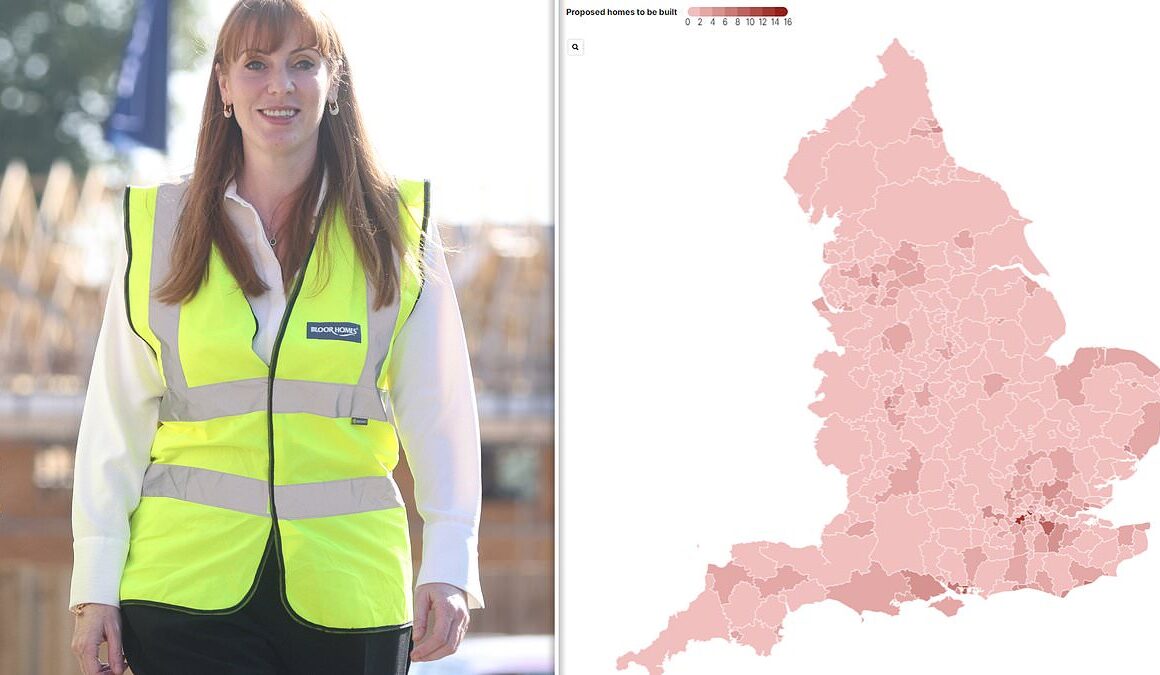Angela Rayner has rubbished ‘nonsense’ claims Labour wants to ‘concrete over’ the countryside as she unveiled her plans for a fresh generation of new towns.
The Deputy Prime Minister, who is spearheading the Government’s bid to deliver 1.5million new homes over the next five years, hit back at critics of her building blitz.
She rejected suggestions Britain is ‘too crowded’ or that there is ‘no countryside left’, saying: ‘The vast majority of England is still very green and will remain so.’
Ms Rayner’s plans for a series of new towns – modelled on ‘garden cities’ like Letchworth and Welwyn – are billed as part of the largest housebuilding effort since the post-war period.
The new towns will each deliver at least 10,000 homes and will be ‘places designed so well that you, me, anyone and everyone would want to live there’, she said.
Ms Rayner set out her plans after yesterday confirming Labour will revive top-down housing targets for local councils.
The collective total for these local targets will be just over 370,000 homes a year and will be calculated using a new method that will include an ‘uplift’ in the most unaffordable areas.
Figures released by Ms Rayner’s Ministry of Housing, Communities and Local Government revealed the proposed new targets for each council area.
It showed how one Tory-controlled council in England will be told to build an astonishing seven times as many houses as it is currently doing.

Angela Rayner has rubbished ‘nonsense’ claims Labour wants to ‘concrete over’ the countryside as she unveiled her plans for a fresh generation of new towns

The Deputy PM, pictured at a development site in Basingstoke yesterday, is spearheading the Government’s bid to deliver 1.5m new homes over the next five years
Ms Rayner has asked two experts – Sir Michael Lyons and Dame Kate Barker – to lead a new taskforce on her plans for new towns.
While some of the new communities set to be built through the programme will be separate from existing towns, others will be urban extensions and regeneration schemes of existing places.
In an article for the Telegraph, Ms Rayner said: ‘Britain’s future towns will be built on the foundations of our past.
‘Our vision for the next generation of new towns across England is for places designed so well that you, me, anyone and everyone would want to live there.’
The Deputy PM, who is also Housing, Communities and Local Government Secretary, admitted ‘people will raise concerns about these plans’.
”Britain is already too crowded!’ they will say, or, ‘There’s no countryside left – it’s all been concreted over!’,’ she added.
Indeed, some surveys indicate that people believe half of England is densely populated.
I could gently reassure them. Or, more likely, I can just say: ‘It’s nonsense.’ Only around 10 per cent of our country is built on.
‘The vast majority of England is still very green and will remain so. We can deliver the 1.5 million homes we have promised in the next five years, and also protect nature.
‘Because our aim is not to build at any cost – but to get building right and to build better.’
In a statement to the House of Commons, Ms Rayner yesterday told MPs her proposed new method for calculating local housing targets will include ‘an uplift where house prices are most out of step with local incomes’.
The Ministry of Housing, Communities and Local Government later released figures showing the expected new targets for each local council.
These were compared to existing targets under the current method, first introduced in 2018, as well as the average number of new homes that have actually been built in recent years.
In Fareham, Labour’s new method would require the local Tory-controlled council to build 794 new houses – up from a target of 498 when calculated by the current method.
This is also nearly seven times the average number of new homes built in the Hampshire town – where Tory ex-home secretary Suella Braverman is the local MP – in 2020/21 and 2022/23 of just 115.

In a statement to the House of Commons, Ms Rayner yesterday confirmed the Government would revive top-down housing targets for local councils

Labour’s proposed new method for calculating local housing targets will include ‘an uplift where house prices are most out of step with local incomes’
Similarly, nearby Portsmouth City Council will be told to build 1,098 new homes under Labour’s new target, up from 897 using the current method.
This is also a huge increase from the 132 new homes that have actually been built, on average, in recent years.
North Yorkshire, where Tory leader Rishi Sunak is a local MP, will be ordered to build 4,232 new homes.
This is up from the 1,361 homes under the current target, although an average of 3,150 new homes were built annually across 2020/21 and 2022/23.
Cornwall will be told to build 4,454 homes under Labour’s target, up from 2,707 using the current method and more than the 2,681 homes built, on average, in recent years.
The Isle of Wight will be told to build more than double the average number of new homes it achieved in those two years (499) under a proposed new target of 1,104.
Overall, the South East will be required to build almost 70,000 new homes a year under the proposed new method for determining housing targets.
This was up from 51,251 under the current method and second only to London (80,693) under the proposed new method.
It was higher than the East of England (45,858), South West (40,343), North West (37,817), West Midlands (31,754), East Midlands (27,382), Yorkshire and The Humber (27,433), and North East (12,202).
Kemi Badenoch, the shadow housing secretary and a Tory leadership candidate, questioned why Labour was reducing the overall housing target for London from nearly 100,000 to around 80,000.
She asked Ms Rayner: ‘Can she explain why she is reducing the need for cities like London to build more housing when they have the infrastructure to support it?
‘Why is she forcing suburban and rural areas to take more housing when there are schoools in Hackney… that are shutting down because they don’t have enough pupils?’
Ms Rayner earlier denied Labour was lowering its ambition for London, saying: ‘The target we’re now setting for London – roughly 80,000 – is still a huge ask but I know it’s one that the mayor is determined to rise to and I met with him last week about this.’
The Deputy PM also set out Labour’s plan to release parts of the protected green belt for development.
These ‘low quality’ areas will be rebranded ‘grey belt’ and include land on the edge of existing housing or roads, as well as disused petrol stations and car parks.
The Government is prepared to ‘step in’ and take over an authority’s local plan in order to ‘drive progress’, the Ministry of Housing, Communities and Local Government warned.
This would ensure local communities ‘get a say on how, but not if, homes are built’, it added.
Ms Rayner told MPs there were 'simply not enough homes' across the country as she blasted the previous Tory government's record on housebuilding.
'They failed to get anywhere near their target 300,000 homes a year and, in a bid to appease their anti-housing backbenchers, they made housing targets only advisable,' she said.
'They knew that this would tank housing supply, but they still did it. And as I stand here today, I can now reveal the result.
'That the number of new homes is now likely to drop below 200,000 this year – unforgivable.'
She added: 'Decisions about what to build should reflect local views… well, that should be about how to deliver new homes, not whether to.
'Whilst the previous government watered down housing targets, caving into their anti-growth backbenchers, this Labour Government is taking the tough choices putting people and country first.
'For the first time we will make local housing targets mandatory, requiring local authorities to use the same method to work out how many homes to build.
'But that alone is insufficient to meet our ambition, so we're also changing the standard method used to calculate housing need so it better reflects the urgency of supply for local areas.
'Rather than relying on outdated data, this new method will require local authorities to plan for homes proportionate to the size of existing communities, and it will incorporate an uplift where house prices are most out of step with local incomes.'

In her Commons statement, Ms Rayner also set out Labour's plan to release parts of the protected green belt for development
Ms Rayner's reforms make explicit that the default answer to brownfield development should be 'yes' and promote homebuilding at greater densities in urban centres, like towns and cities.
But because there is not enough brownfield land in the country to meet housing needs, the Government will allow the targeted release of 'grey belt' land.
Any green belt land released will be subject to 'golden rules' to ensure the development delivers 50 per cent affordable homes and has access to green spaces and infrastructure such as schools and GP surgeries.
The method for local authorities to calculate how much land they must allocate for new housing, which relied on data from 2014, will be updated to ensure stock is boosted in every part of the country.
Labour are also laying the groundwork for universal local plan coverage across England.
With only a third of councils currently having a plan that is under five years old, ministers will be ready to intervene to ensure they all have one in place by a specified point next year, taking over a local plan if insufficient progress is made.
Ms Rayner also unveiled immediate measures to counter the decline in the number of social and affordable housing through new flexibilities for councils, including allowing them to use their right-to-buy receipts to build and buy more social homes.
'Today I'm calling on local authorities, housing associations and industry to work with me to deliver a council house revolution,' Ms Rayner told the Commons, promising the 'biggest boost to social and affordable housing in a generation'.
Details of Government investment in the form of direct grant funding for social and affordable housing, as well as on rent stability, will be brought forward at the autumn spending review.
Labour also intends to drop the requirement for new homes to be 'beautiful', introduced by the Conservatives, arguing it is subjective, difficult to define and leads to inconsistent decision-making on applications.
The ruling party's manifesto used different language, outlining instead its aim for 'exemplary' development to be 'the norm not the exception'.
A new draft National Planning Policy Framework, which sets out planning policies for England, will go out to consultation for eight weeks from Tuesday.
Cllr Richard Clewer, housing and planning spokesman for the County Councils Network, said: 'The CCN will be consulting with its members on the new methodology for housing numbers, but we have always been clear that local authorities know their areas best and that housing should be fairly distributed across the entirety of the country.
'County areas have delivered 600,000 homes in the past five years – higher than the rest of the country combined.
'However, on face value, this new methodology assigns more to rural areas that currently do not have sufficient infrastructure and less to urban locations that have more readily available infrastructure.'







